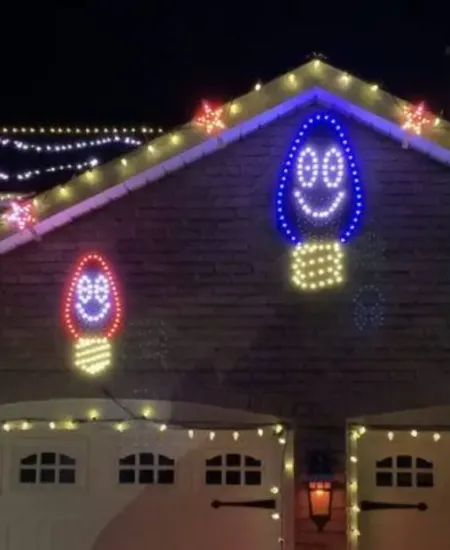Introduction to DIY Animated Light Displays
Remember the first time you saw an animated light display that literally stopped you in your tracks? Maybe it was during a Christmas festival, or perhaps a neighbor had transformed their garden into a winter wonderland with lights that danced to the tune of "Jingle Bells". If you're like me, the magic of those moments was enough to make you think, "How can I do something like this at home?" Well, gear up because today we're diving into the world of DIY animated light displays!
Understanding the Basics: What Makes Lights Dance?
Before we jump into the nuts and bolts, let's talk a little about what makes these displays more than just your average holiday decoration. Animated light displays combine lights, music, and sometimes even additional mechanics to create scenes or stories that unfold right before your eyes.
The magic behind these dancing lights is a combination of hardware and software. Essentially, you use a control system to choreograph how and when each light turns on and off, syncing it with music. It sounds complex, and honestly, it can be—but don’t worry, I’ve broken down the steps and added a few personal tales of trial and error that might save you some trouble.
Choosing Your Design and Tools
When I first decided to take on this project, I spent countless nights dreaming up elaborate scenes. Did I want a simple display with twinkling effects, or was I ready to recreate the entire opening scene from "The Nutcracker"? You'll need to make a similar choice based on how much time, money, and space you have.
- Sketch Your Vision: Start with a sketch of your display. It doesn’t have to be a masterpiece, but some visual reference will guide your project.
- Select Your Lights: LED lights are popular due to their longevity and energy efficiency. You’ll need to decide between RGB LEDs (which can make any color under the sun) and single-color LEDs.
- Control Systems: For the magic to happen, a controller is essential. This can be as simple as a hardware controller from a store like Light-O-Rama or DIY options like Arduino or Raspberry Pi for the more technically inclined. For the tech-savvy, designing and programming Arduino-based light shows opens up a world of creative possibilities. (instructables.com)
- Software: This is what you’ll use to design the choreography of your lights. Some controllers come with their own software, or you can venture into open-source options like xLights or Vixen Lights. (xlights.org)
I remember my first controller setup, and let’s just say, my living room looked more like a mad scientist's lab than a festive home. Wires everywhere, a soldering iron left perilously close to a fabric Santa hat—chaotic but thrilling.
Assembling Your Hardware
With your design outlined and tools in hand, it’s time to build your control system. If you’re using a pre-built controller, much of the heavy lifting is done for you. But for those going the DIY route with a Raspberry Pi or Arduino, prepare for a fun challenge.
- Power Supplies: Make sure your power supply can handle your system’s voltage requirements. Safety tip: always check and double-check these specs!
- Controller to Light Connection: Depending on your controller, this might involve some wiring work. At one point, I accidentally mixed up the positive and negative wires—it wasn’t pretty.
- Weatherproofing: Since most light displays are outdoors, protecting your equipment from the elements is crucial. I use plastic enclosures and silicone sealant to weatherproof my connections. (instructables.com)
If you're considering expanding your display, a Christmas light mega tree makes for a spectacular centerpiece that pairs well with any animated setup.
Programming Your Display
The first time I sat down to program my lights, I felt like a conductor ready to orchestrate a symphony... that is until I realized I knew nothing about music timing. Needless to say, there’s a learning curve.
You’ll spend time synchronizing your lights with music. This process can be meticulous—counting beats, adjusting timings, and tweaking until it’s just right. Programs like xLights have tutorials that can help beginners get their bearings.
Troubleshooting Common Issues
Let’s be real: something is bound to go wrong. Maybe your lights won’t sync, or the controller decides to go on strike. Here are a few common issues:
- Connectivity Issues: Always ensure your connections are secure. A loose wire can be the difference between a flawless show and one that flickers out.
- Software Glitches: Update your software regularly, and don’t shy away from forums or user groups—these are goldmines of information and support. (doityourself.com)
- Power Surges: Use surge protectors to safeguard your equipment and investment. There's nothing sadder than a fried controller come Christmas Eve.
In retrospect, all those evenings spent troubleshooting under a blanket of stars were half the fun. They left me not only with a dazzling light display but also a host of new skills and stories to share.
Final Takeaways and Heartfelt Call to Action
Designing your own animated light display isn't just about celebrating a season; it's about challenging yourself, learning new skills, and creating magic that can bring joy to people's faces. Whether you're aiming for a modest setup or envisioning a spectacular show, the journey is worth every moment.
If there’s one piece of advice I’d give from my own experience, it’s this: start small, dream big, and let your lights do the talking. Who knows? Maybe next year, it’ll be your display stopping passersby in their tracks.
Why not grab a warm drink, sketch out some ideas, and start planning your display today? After all, the best Christmas present might just be one you build yourself.
Subscribe to our email newsletter and unlock access to members-only content and exclusive updates.

Comments